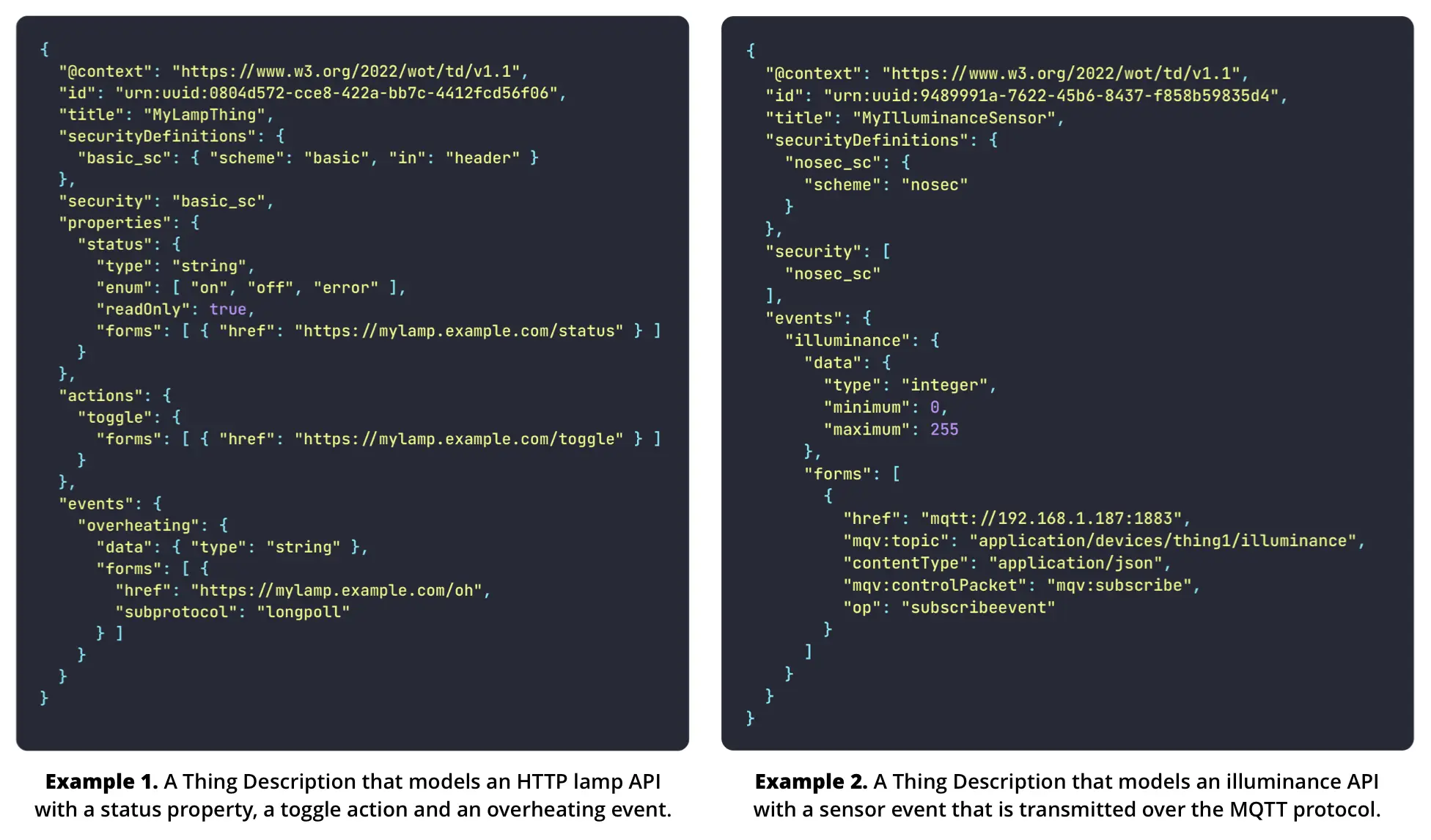How the W3C Web of Things brings JSON Schema to the Internet of Things
Challenge
The Internet of Things (IoT) is the network of physical "smart" objects that exchange data with other devices over the Internet. While communication and interoperability are by definition the crux of the Internet of Things, the emergence of custom or proprietary solutions results in devices that cannot talk to each other due to differences in data interchange mechanisms.
To integrate these disparate devices, developers must work with a growing set of protocols, serialization formats and API specifications. This results in repetitive, non-scalable and error-prone work that is difficult to automate.
While technologies like OpenAPI and AsyncAPI largely solve this problem in the context of Web APIs, they fall short for describing networks of non-HTTP and multi-protocol devices, and do not consider different modes of interaction based on their meaning in the physical world.
Solution
To solve these problems, the W3C Web of Things works on providing standardized building blocks that make use of JSON Schema.
JSON Schema is used for validating descriptions of network-facing capabilities of physical entities called Thing Descriptions, and to model and describe data sent by Internet of Things consumers and producers in a multi-protocol manner.
The W3C Web of Things specifications are on board with JSON Schema since Draft 4, and even the first draft versions already catered to data models of Internet of Things devices. "Currently, we are on JSON Schema Draft 7 and expect to move to JSON Schema 2020-12 or a newer one when starting our new charter in February 2023," said Ege Korkan, Research Scientist at Siemens and W3C Specifications editor.
"We observe JSON Schema becoming more and more stable over the years and Postman's support to the community gives us even more confidence on it," continued Ege Korkan.
JSON Schema is delivering exciting features, and more importantly these features are becoming more and more consistent across implementations. For example, Ege Korkan added, "JSON Schema vocabularies are very promising and we plan to explore them further in conjunction with Semantic Web technologies."
Impact
The W3C Web of Things relies on JSON-LD for linking vocabularies and ontologies that already exist on the web, such as [SAREF][#saref], [Units of Measure][#units-of-measure] and [Schema.org][#schema-org]. Being based on the JSON data model, JSON Schema fits well with JSON-LD when integrating both technologies as part of a single specification.
Adopting JSON Schema means that the W3C Web of Things does not need to invest effort on inventing another schema language. As a consequence of the popularity of JSON Schema, existing tooling can be often reused instead of implementing custom parsers, validators, code generators and UI generators for all the programming languages that the community might be interested in.
JSON Schema has proven to be a foundational block for creating higher-level tooling that is specific to the W3C Web of Things. As a notable example, the community has developed a tool called testbench that makes use of JSON Schema definitions inside Thing Descriptions to generate matching payloads for the purpose of stress and penetration testing.
Given the growing popularity of using JSON Schema to generate web-based forms, W3C Web of Things specifications can be used to automatically generate dashboards and user interfaces to interact with the objects modeled by Thing Descriptions.
Key Impact Results
The ultimate metric of success for a standard like the W3C Web of Things is adoption, and community adoption is not something you can just "engineer". Ege Korkan commented, "since we adopt JSON Schema, developers who are familiar with it have a smaller learning curve when learning the W3C Web of Things standard."
"During my PhD times, my MSc engineering students had to become familiar with the W3C Web of Things. These students typically took 1 week to go through my tutorial. If they knew JSON Schema, that 1 week would become 2 days", said Ege Korkan.
W3C Web of Things
The World Wide Web Consortium (W3C) is the standardization organization behind most of the standards used in the Web. The W3C Web of Things Working and Interest Groups work on the standardization of Web of Things at W3C.
The Web of Things groups aim to create an interoperability layer so that different Internet of Things platforms, protocols and standards can operate together.
The work started as a discussion in the Web of Things Community Group in 2013-2014. It proceeded to become an Interest Group in 2015 that collected the use cases and defined the standards to be worked on. Since 2016, the working group is working on different standards on the Web of Things with the first publications of the Thing Description and Architecture recommendations in 2019 and more that will be published by the end of this year.
At the time of this writing, the Working Group consists of 96 participants representing 36 organizations and the Interest Group consists of 131 participants representing 48 organizations.

Getting Started
The W3C Web of Things Working Group invites you to leverage your existing JSON Schema knowledge to play with the Internet of Things through the use of the W3C Web of Things specifications and tools. You might already have a smart device next to you, just that it does not come with a Thing Description!
If you write your own Thing Description, you can programatically interact with your device by using the Node.js Web of Things implementation, or play with it through the Node-RED integration.
To learn more, head over to the documentation, watch the introductory videos, have a look at the many examples provided as part of the Thing Description specification and try them out on the Thing Description Playground app.
Thank you to Ege Korkan, Web of Things Researcher at Siemens AG, Munich, the W3C Web of Things Working and Interest Groups and Coralie Mercier from the W3C Marketing and Communications Team for allowing and enabling us to share this case study with you.
Cover image: Hello WoT © 2022 by desertmonitor OÜ is licensed under CC BY-ND 4.0